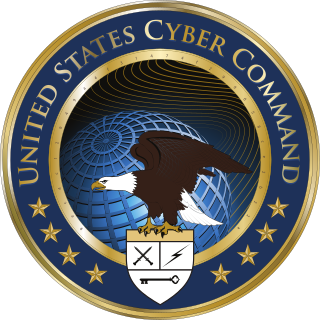
Computer security, cybersecurity, or information technology security is the protection of computer systems and networks from information disclosure, theft of or damage to their hardware, software, or electronic data, as well as from the disruption or misdirection of the services they provide.
Information warfare (IW) manipulates information trusted by targets without their awareness, so that the targets will make decisions against their interest but in the interest of the one conducting information warfare. It is a concept involving the battlespace use and management of information and communication technology (ICT) in pursuit of a competitive advantage over an opponent. Information warfare is the manipulation of information trusted by a target without the target's awareness so that the target will make decisions against their interest but in the interest of the one conducting information warfare. As a result, it is not clear when information warfare begins, ends, and how strong or destructive it is. Information warfare may involve the collection of tactical information, assurance(s) that one's information is valid, spreading of propaganda or disinformation to demoralize or manipulate the enemy and the public, undermining the quality of the opposing force's information and denial of information-collection opportunities to opposing forces. Information warfare is closely linked to psychological warfare.
Cyberterrorism is the use of the Internet to conduct violent acts that result in, or threaten, the loss of life or significant bodily harm, in order to achieve political or ideological gains through threat or intimidation. Acts of deliberate, large-scale disruption of computer networks, especially of personal computers attached to the Internet by means of tools such as computer viruses, computer worms, phishing, malicious software, hardware methods, programming scripts can all be forms of internet terrorism. Cyberterrorism is a controversial term. Some authors opt for a very narrow definition, relating to deployment by known terrorist organizations of disruption attacks against information systems for the primary purpose of creating alarm, panic, or physical disruption. Other authors prefer a broader definition, which includes cybercrime. Participating in a cyberattack affects the terror threat perception, even if it isn't done with a violent approach. By some definitions, it might be difficult to distinguish which instances of online activities are cyberterrorism or cybercrime.

Cyberwarfare is the use of digital attacks to attack a nation, causing comparable harm to actual warfare and/or disrupting the vital computer systems. There is significant debate among experts regarding the definition of cyberwarfare, and even if such a thing exists. One view is that the term "cyberwarfare" is a misnomer, since no offensive cyber actions to date could be described as "war". An alternative view is that "cyberwarfare" is a suitable label for cyber attacks which cause physical damage to people and objects in the real world.
The Joint Worldwide Intelligence Communication System is the United States Department of Defense's secure intranet system that houses top secret and sensitive compartmented information. JWICS superseded the earlier DSNET2 and DSNET3, the Top Secret and SCI levels of the Defense Data Network based on ARPANET technology.
A cyber force is a military branch devoted to cyberwarfare, cybersecurity, and counter-cyberwarfare. Its responsibilities could also include operations to combat cyberterrorism and to establish cyber power projection. A cyber force can be part of a military branch or a combined command. Presently, it has no official definition although the United States Department of Defense Dictionary of Military and Associated terms provided relevant concepts that indicate cyber force could be constituted by personnel who conduct cyberspace operations in cyberspace and the activities include computer network operations, and the routine operation and defense of cyberspace.
Proactive cyber defence means acting in anticipation to oppose an attack through cyber and cognitive domains. Proactive cyber defence can be understood as options between offensive and defensive measures. It includes interdicting, disrupting or deterring an attack or a threat's preparation to attack, either pre-emptively or in self-defence. Common methods include cyber deception, attribution, threat hunting and adversarial pursuit. The mission of the pre-emptive and proactive operations is to conduct aggressive interception and disruption activities against an adversary using: psychological operations, managed information dissemination, precision targeting, information warfare operations, computer network exploitation, and other active threat reduction measures. The proactive defense strategy is meant to improve information collection by stimulating reactions of the threat agents and to provide strike options as well as to enhance operational preparation of the real or virtual battlespace. Proactive cyber defence can be a measure for detecting and obtaining information before a cyber attack, or it can also be impending cyber operation and be determining the origin of an operation that involves launching a pre-emptive, preventive, or cyber counter-operation.

United States Cyber Command (USCYBERCOM) is one of the eleven unified combatant commands of the United States Department of Defense (DoD). It unifies the direction of cyberspace operations, strengthens DoD cyberspace capabilities, and integrates and bolsters DoD's cyber expertise.
Cyberwarfare in the United States pertains the use of computer technology to disrupt the activities of a state or organization, especially the deliberate attacking of information systems for strategic or military purposes. The country has substantial capabilities in both defense and power projection due to the comparatively advanced technology and a large military budget. Cyber warfare presents a growing threat to physical systems and infrastructures that are linked to the internet.

The U.S. Marine Corps Forces Cyberspace Command is a functional formation of the United States Marine Corps to protect critical infrastructure from cyberattack. Marine Corps Forces Cyberspace Command is the Marine Corps component to U.S. Cyber Command. It comprises a command element, the Marine Corps Cyber Operations Group, and the Marine Corps Cyber Warfare Group, a total of approximately 800 personnel. MARFORCYBER was established on January 21, 2010 under the command of LtGen George J. Flynn,. As of 7 July 2021, MajGen Ryan P. Heritage is in command.
Jeffrey Carr is a cybersecurity author, researcher, entrepreneur and consultant, who focuses on cyber warfare.
Informatized warfare of China is the implementation of information warfare (IW) within the Chinese military. Laid out in the Chinese Defence White Paper of 2008, informatized warfare includes the utilization of information-based weapons and forces, including battlefield management systems, precision-strike capabilities, and technology-assisted command and control (C4ISR). However, some media and analyst report also uses the term to describe the political and espionage effort from the Chinese state.
The 2011 U.S. Department of Defense Strategy for Operating in Cyberspace is a formal assessment of the challenges and opportunities inherent in increasing reliance on cyberspace for military, intelligence, and business operations. Although the complete document is classified and 40 pages long, this 19 page summary was released in July 2011 and explores the strategic context of cyberspace before describing five “strategic initiatives” to set a strategic approach for DoDʼs cyber mission.

The U.S. Fleet Cyber Command is an operating force of the United States Navy responsible for the Navy's information network operations, offensive and defensive cyber operations, space operations and signals intelligence. It was created in January 2010 "to deter and defeat aggression and to ensure freedom of action to achieve military objectives in and through cyberspace". U.S. Tenth Fleet was simultaneously reactivated as its force provider. Since it was founded, the command has grown into an operational force composed of more than 16,000 active and reserve sailors and civilians organized into 27 active commands, 40 Cyber Mission Force units, and 27 reserve commands around the world.
A cyberattack is any offensive maneuver that targets computer information systems, computer networks, infrastructures, or personal computer devices. An attacker is a person or process that attempts to access data, functions, or other restricted areas of the system without authorization, potentially with malicious intent. Depending on the context, cyberattacks can be part of cyber warfare or cyberterrorism. A cyberattack can be employed by sovereign states, individuals, groups, society, or organizations, and it may originate from an anonymous source. A product that facilitates a cyberattack is sometimes called a cyber weapon.
A Master of Science in Cyber Security is a type of postgraduate academic master's degree awarded by universities in many countries. This degree is typically studied for in cyber security. What is offered by many institutions is actually called a Master in Strategic Cyber Operations and Information Management (SCOIM) which is commonly understood to be a Master in Cybersecurity. This degree is offered by at least some universities in their Professional Studies program so that it can be accomplished while students are employed - in other words it allows for "distance learning" or online attendance. Requirements for the Professional Studies program include: 3.0 or better undergrad GPA, professional recommendations letters and an essay.

Gabriel "Gabi" Siboni is a colonel in the Israel Defense Forces Reserve service, and a senior research fellow and the director of the Military and Strategic Affairs and Cyber Security programs at the Institute for National Security Studies. Additionally, he serves as editor of the tri-yearly published, Military and Strategic Affairs academic journal at INSS. Siboni is a senior expert on national security, military strategy and operations, military technology, cyber warfare, and force buildup. Siboni is as a Professor at the Francisco de Vitoria University in Madrid.
Cyber threat intelligence is information about threats and threat actors that helps mitigate harmful events in cyberspace. Cyber threat intelligence sources include open source intelligence, social media intelligence, human Intelligence, technical intelligence or intelligence from the deep and dark web.

The Joint Cyberspace Command (MCCE), known until 2020 as Joint Cyber-Defence Command (MCCD), is a Spanish cyberspace service of the Defence Staff responsible for planning and carrying out he actions related to cyber defence in networks and information and telecommunications systems of the Ministry of Defense or others that might be entrusted, as well as contributing to the adequate response in cyberspace to threats or aggressions that may affect to the National Defense.







